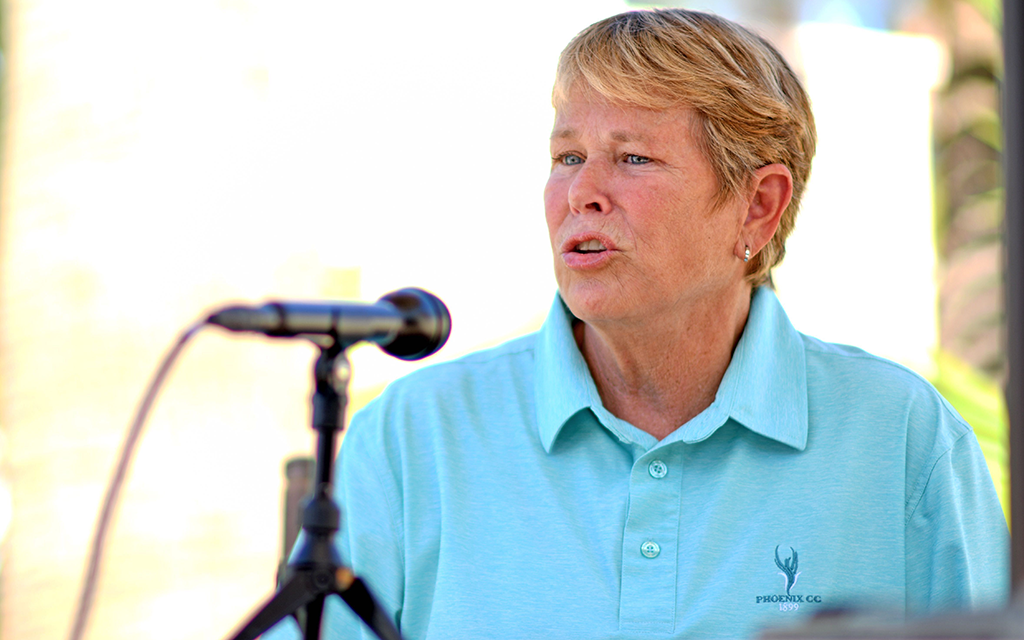
Ann Meyers Drysdale’s contributions to women’s basketball continue to resonate through the sport’s evolution and increased popularity. (File photo by Kevin Hurley/Cronkite News)
PHOENIX – Whenever Caitlin Clark sinks a smooth jump shot, Ann Meyers Drysdale probably smiles. When Angel Reese forces a turnover, Meyers Drysdale likely nods in approval. When JuJu Watkins attacks the rim in the blink of an eye, Meyers Drysdale must feel like offering a fist bump.
Five decades might separate Meyers Drysdale from today’s female college basketball players, but a true baller’s heart always beats slightly faster this time of the year.
March Madness is upon us, and the excitement surrounding women’s basketball is real. Rising stars like Clark, Reese and Watkins are receiving extensive coverage. The level of attention compared to the era when Meyers was on the court illustrates the monumental progress women’s basketball has made.
“Incredible, like trail-blazing, groundbreaking; it’s really easy to look at Angel Reese and Caitlin Clark and all of the buzz around women’s college basketball right now, and not realize that 40 years ago, it wasn’t this way,” said Bob Adlhoch, executive producer for the Suns and Mercury. “When Ann was playing, she was this diamond.”
Watching the sport’s explosion and the accompanying intense media coverage brings joy to Meyers, who turned 69 last month.
The impact Clark has made on women’s basketball is incredible. According to CNN, the average cost of an Iowa women’s basketball’s 2023-24 regular-season game is $571 while other NCAA women’s basketball games average $49 per ticket. Back in 1979, watching Meyers Drysdale play in person only cost $5.50. The sport’s growth took decades, but now the popularity has increased, and fans are excited about the future.
“Caitlin Clark and what she’s doing have brought a great focus on the game and its history,” Meyers said of the Iowa guard, who this season became the NCAA Division I all-time leading scorer and is regarded as one of the greatest players in women’s college basketball history. “Thank goodness for her because now the media is comparing her to Pete (Maravich) which is rubbish.”
While the Men’s Final Four has garnered much of the attention in the Valley, partly because it takes place at State Farm Stadium in Glendale Saturday and Monday, the women’s Final Four in Cleveland is equally compelling. Undefeated South Carolina, seeded No. 1 overall, faces No. 3 North Carolina State Friday followed by No. 1 seed Iowa against No. 3 UConn in the other bracket, all battling for a chance to hold the trophy Sunday and be referred to as National Champions.
Sunday’s championship game is expected to draw record crowds and TV viewership could surpass the more than 12 million people who tuned in to watch last Monday’s Elite Eight showdown between LSU and Iowa, which was a repeat of last year’s title game. The audience for the 2024 showdown peaked at 16.1 million viewers, according to ESPN. In January, the NCAA and ESPN announced a $920 million, eight-year agreement that gives the network exclusive broadcast rights to 40 championships, including the Division I women’s basketball tournament.
This is a far cry from when Meyers Drysdale ruled the court at UCLA from 1974-78, when she made history by becoming the first woman to receive a full-ride scholarship. In the 1970s women’s sports were different. Meyers Drysdale recalls the team taking station wagons and vans to away games instead of planes and staying in motels with four players to a room.
But Meyers Drysdale’s championship season in 1978 was remarkable; it was her last time playing in a UCLA uniform. The title game was played at UCLA’s Pauley Pavilion and every seat was filled to witness Meyers Drysdale have her own one shining moment cutting down the net after victory and hearing the UCLA band play “Happy Birthday” to celebrate Meyers Drysdale turning 23. The Bruins defeated Maryland 90-78 to win the Association for Intercollegiate Athletics for Women (AIAW) title.
“Well, we had almost 10,000 and that was the largest crowd at that time,” Meyers Drysdale said. “Certainly there was a lot of awareness in Los Angeles and around the country because of going back to my freshman year.”

Ann Meyers Drysdale, a trailblazer in women’s basketball, watches with pride as today’s rising stars like Caitlin Clark, Angel Reese and JuJu Watkins make their mark on the court during March Madness. (Photo by Tim Bradbury/Getty Images)
When Meyers Drysdale played, women’s sports were not televised and showcased like they are today where games are all over ESPN, and sports bars cater specifically to women’s sports. With the rise of social media, female athletes have broadened their appeal and can market themselves to fans worldwide.
“We didn’t have ESPN, we didn’t have podcasts. We didn’t have the internet,” Meyers Drysdale said. “We didn’t have all these sports outlets they have today. The fact that you’ve got you know, most of us didn’t know each other from one end of the country to the other.”
Meyers Drysdale continued to make history by setting 12 out of 13 school records on the basketball court and winning a national championship in the high jump with the Bruins’ track and field team. Her basketball jersey, No. 15, was the first woman to be retired by the school, symbolizing her trailblazing career and further solidifying her status as a pioneer in women’s sports.
After Meyers graduated college, she played basketball for the U.S. National Team, won a silver medal with the U.S. in the 1976 Summer Olympics in Montreal, and had a chance to travel worldwide.
During that time, Meyers received attention from the Women’s Basketball League (WBL). After her initial Olympics run, she became the first player to be drafted in the WBL by the Houston Angels, though she chose not to sign with the team to remain an amateur for the 1980 Olympics.
During Meyer’s time playing for the National Team, she earned a gold medal and several silver medals in international competitions. She returned home and received a call from Sam Nassi, the owner of the Indiana Pacers, who asked her to come and try out for the NBA team.
“So, making that decision to leave the USA team was very hard for me, but I looked at it as an opportunity of a lifetime that most men don’t get,” Meyers said.
Meyers Drysdale was signed in 1979 by the Pacers as a free agent for $50,000. That moment cemented the history of the first woman to get a try-out and sign with an NBA team. With that, there was plenty of criticism questioning her talents and whether the signing was a publicity stunt.
“So I think it was always staying positive,” Meyers said. “Mentally, I had helped with that again with my family. They were always in my corner.”
Meyers did not make the final roster, but she did make history.
“I wasn’t going to let people talk me out of something that somebody gave me an opportunity,” Meyers said. “So even though I didn’t make the team, and a lot of people in the media were saying, ‘You failed! You failed!’ I didn’t fail at anything. I gave it a shot and it wasn’t up to me to make the decision.”
Meyers went back to the WBL after the tryout from the Pacers. The Angels traded her rights to the New Jersey Gems, where Meyers had an incredible second season with the team, winning MVP and leading the league in scoring.
Once Meyers’s basketball career ended, she ventured down a different path to continue her love of basketball. Growing up, Meyers was very quiet and reserved, but this changed when she met her husband, Don Drysdale, who became a broadcaster after a Hall-of-Fame career as a pitcher for the Los Angeles Dodgers.
Meyers began attending school for broadcasting. One of her first broadcasts was for the Goodwill Games, which featured two NBA legends, Rick Barry and Bill Russell.
Meyers continued to be a color analyst for various sports, including men’s and women’s basketball, the NBA, tennis and even the Olympics. She began working with the Indiana Pacers and became the first woman to broadcast an NBA game.
In 2007, Meyers’ career took a different turn when she was offered the position of general manager for the Phoenix Mercury. She helped the Mercury win a championship in her first year as GM. Her impact on and off the court for the Mercury can not go unrecognized.
“Her love for this organization, and the game itself,” said Vince Kozar, the president of the Mercury, ticking off Meyers Drysdale’s everlasting appeal to the Valley. “You know, she’s still out there doing community events and appearances for us just because she cares about us.”
Meyers Drysdale moved on from being the general manager, but she is still working for the organization as a color analyst for the Suns and Mercury.
Meyer’s resume is incredible. She has been inducted into the Naismith Hall of Fame, FIBA Hall of Fame, and the Southern California Sports Broadcasters Hall of Fame and has an award named after her for the best player in women’s basketball.
In 2024, during the NBA All-Star weekend, she was awarded the Kobe and Gigi Bryant award for her contributions to the women’s game. Meyers’s impact on the sport will never be forgotten.
“The fact that she’s still doing it today,” Kozar said. “I don’t think it’s an overstatement to say that there’s really not someone who’s had a bigger impact on the women’s game.”
